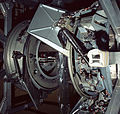- Androgynous Peripheral Attach System
-
The Androgynous Peripheral Attach System, or Androgynous Peripheral Assembly System, is a spacecraft docking mechanism used on the International Space Station.[1] It is used to dock the Space Shuttle orbiter and to connect the Functional Cargo Block (Zarya) to Pressurized Mating Adapter-1.[2] A system compatible with APAS is used by the Chinese Shenzhou spacecraft making it possible for that spacecraft to dock with the ISS.[3]
Contents
Design
APAS was designed by Vladimir Syromyatnikov of the Moscow-based RSC Energia and has roots in the Apollo-Soyuz program.[4] The idea behind the design is that unlike with the probe-and-drogue docking system, any APAS docking ring can mate with any other APAS docking ring, both sides are androgynous. In each docking there is however, an active and a passive side, but both sides can fulfill either role. There are 3 basic variations of the APAS system.
APAS-75
APAS-75 was developed for the Apollo–Soyuz Test Project (ASTP). Unlike previous docking systems, both units could assume the active or passive roles as required. For docking, the spade-shaped guides of the extended active unit (right) and the retracted passive unit (left) interacted for gross alignment. The ring holding the guides shifted to align the active unit latches with the passive unit catches. After these caught, shock absorbers dissipated residual impact energy in the American unit; mechanical attenuators served the same function on the Soviet side. The active unit then retracted to bring the docking collars together. Guides and sockets in the docking collars completed alignment. Four spring push rods drove the spacecraft apart at undocking.[5] Russia built five Soyuz spacecraft that used APAS-75. The first three flew as test systems (Cosmos 638, Cosmos 672 and Soyuz 16). One was used for the Apollo-Soyuz Test Project, Soyuz 19 the only Soyuz to actually use the docking system, and the last one flew as Soyuz 22. On the American side the ASTP Docking Module carried one APAS-75 docking collar and one Apollo docking collar.
APAS-89
When Russia started working on Mir they were also working on the Buran shuttle program. APAS-89 was envisioned to be the docking system for Buran with the Mir space station. The original design was heavily modified. The outer diameter was reduced from 2030 mm to 1550 mm and the alignment petals were pointed inward instead of outward. This limited the internal diameter of the docking port to about 800 mm[citation needed]. The Buran shuttle was finally canceled in 1994 and never flew to the Mir space station, but Mir's Kristall module was outfitted with two APAS docking collars. The Mir Docking Module, basically a spacer module between Kristall and the Shuttle also used APAS-89 on both sides. This design is sometimes called Androgynous Peripheral Docking System.
APAS-95
When the Shuttle-Mir Program began APAS was selected as the docking system. The visiting US Space Shuttles used an Androgynous Peripheral Attach System docking collar originally designed for Buran, mounted on a bracket originally designed for use with the American Space Station Freedom. Although Energia's code for the Shuttle APAS is APAS-95, it is basically the same as APAS-89.[6] The APAS on the Shuttle's Orbiter Docking System remained unchanged when it began to be used for ISS dockings. The active capture ring that extends outward from the orbiter will capture the passive mating ring on the space station's Pressurized Mating Adapters. The capture ring aligns them, pulls them together and deploys 12 structural hooks, latching the two systems with an airtight seal. The Pressurized Mating Adapters are permanently passive.
Images
See also
External Links
References
- ^ "What is an Androgynous Peripheral Attach System?". NASA. http://spaceflight.nasa.gov/dayfacts/2000/0118.html. Retrieved 2008-04-07.
- ^ "Androgynous Peripheral Attach System". Boeing. http://www.boeing.com/defense-space/space/spacestation/components/apas.html. Retrieved 2008-04-07.
- ^ "Testimony of James Oberg: Senate Science, Technology, and Space Hearing: International Space Exploration Program". spaceref.com. http://www.spaceref.com/news/viewsr.html?pid=12687. Retrieved 2008-04-07.
- ^ Patricia Sullivan (October 1, 2006). "Vladimir Syromyatnikov; Designed Docking System for Space Capsules". The Washington Post. http://www.washingtonpost.com/wp-dyn/content/article/2006/09/30/AR2006093001038.html. Retrieved 2008-04-05.
- ^ David S. F. Portree. "Mir Hardware Heritage". Lyndon B. Johnson Space Center. http://ston.jsc.nasa.gov/collections/TRS/_techrep/RP1357.pdf. Retrieved 2008-04-05.
- ^ Energiya-Buran: The Soviet Space Shuttle. Chichester, UK: Praxis Publishing Ltd. 2007. pp. 379–381. ISBN 978-0-387-387-69848-9. http://books.google.com/books?id=VRb1yAGVWNsC&dq=%22APAS-95%22+nasa&source=gbs_navlinks_s. "Although Energiya's internal desginator for the Shuttle APAS is APAS-95, it is essentially the same as Buran's APAS-89"
Mir Soviet modules 
Russian/American modules Other subsystems Visiting spacecraft Other articles Shuttle-Mir programme · Deorbit of Mir · MirCorp
List of Mir spacewalks · List of human spaceflights to Mir · List of Mir Expeditions · List of Mir visitors · List of unmanned spaceflights to MirCategories:- Spacecraft components
- Spacecraft docking systems
- Components of the International Space Station
- Soviet inventions
- Russian inventions
- Mir
- Soviet Union–United States relations
Wikimedia Foundation. 2010.






